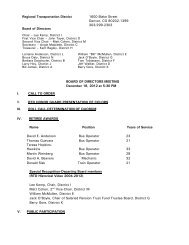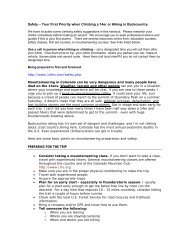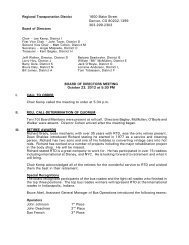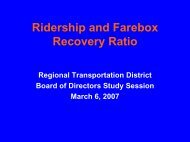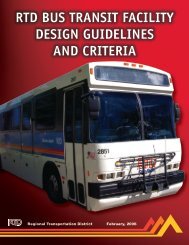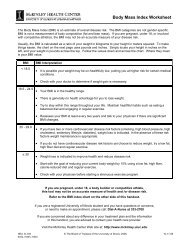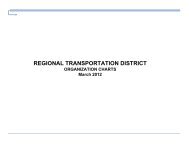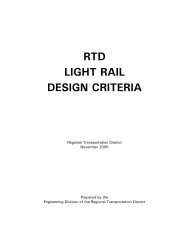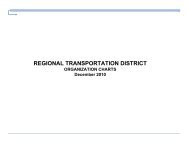Commuter Rail AC Electrification Load-Flow Simulation Report - RTD
Commuter Rail AC Electrification Load-Flow Simulation Report - RTD
Commuter Rail AC Electrification Load-Flow Simulation Report - RTD
Create successful ePaper yourself
Turn your PDF publications into a flip-book with our unique Google optimized e-Paper software.
<strong>Commuter</strong> <strong>Rail</strong> <strong>AC</strong> <strong>Electrification</strong> <strong>Load</strong>-<strong>Flow</strong> <strong>Simulation</strong> <strong>Report</strong> Revision 1<br />
3.3.4 Paralleling Stations<br />
Paralleling stations are an integral part of the autotransformer-fed system. Since substation to<br />
switching station spacing is often large, each section of the distribution system may be equipped<br />
with one or more paralleling stations. The paralleling stations are installed either between the<br />
substation and the switching station or between the substation and end of the line in order to<br />
improve the voltage profile along the system by transforming the feeder/catenary voltage to<br />
catenary/rail voltage using autotransformers. Further, the paralleling stations parallel the<br />
catenary and feeder circuits of the two tracks and provide electrical sectioning points within the<br />
system.<br />
Each paralleling station is equipped with medium voltage indoor switchgear or outdoor circuit<br />
breakers configured in a similar arrangement as in the switching stations. However, since the<br />
autotransformer feeder and the catenary voltages on either side of the paralleling stations are<br />
always of the same phase and magnitude, there is no need for bus-tie circuit breakers. For the<br />
same reason, overlaps or section insulators are used in paralleling stations instead of phase<br />
breaks.<br />
3.3.5 Benefits of Paralleling Stations and Switching Stations<br />
A key advantage of this arrangement is that the switchgear in the switching and the paralleling<br />
stations enables sections of the distribution system to be disconnected following a fault or for<br />
routine maintenance. The switchgear is configured to permit paralleling of the overhead<br />
distribution system conductors in multiple track areas. The conductor paralleling decreases the<br />
effective system impedance between substations and trains which improves the train voltage<br />
profile along the system. The paralleling also provides for current sharing between conductors<br />
of adjacent tracks and improves system fault detection.<br />
3.3.6 Autotransformers<br />
In the autotransformer system, the catenary-rail voltage is delivered by the feeder-catenary<br />
distribution system via autotransformers. Autotransformers are installed at each paralleling<br />
station and at each switching station. The autotransformer winding ratio must correspond to the<br />
distribution voltage (feeder-to-catenary) and the traction voltage (catenary-to-rail) ratio.<br />
The autotransformer-fed system enables power to be distributed along the system at higher<br />
than the train utilization voltage. For example, in the 2x25 kV autotransformer system, power is<br />
distributed at 50 kV (line-to-line) while the trains operate at 25 kV (line-to-ground). This<br />
arrangement results in a system with lower voltage drop along the alignment than is possible<br />
with 25 kV direct-fed system, resulting in an improved train voltage profile along the line.<br />
Depending on the train position along the system, the current in the feeder may flow in the<br />
opposite direction than the current in the catenary. In this event, certain electromagnetic field<br />
cancelation occurs. This field cancelation mitigates, to some degree, the effects of<br />
electromagnetic interference on other wayside equipment as well as communications and<br />
signaling circuits.<br />
02/27/2009 FRSC Page 10 of 250




